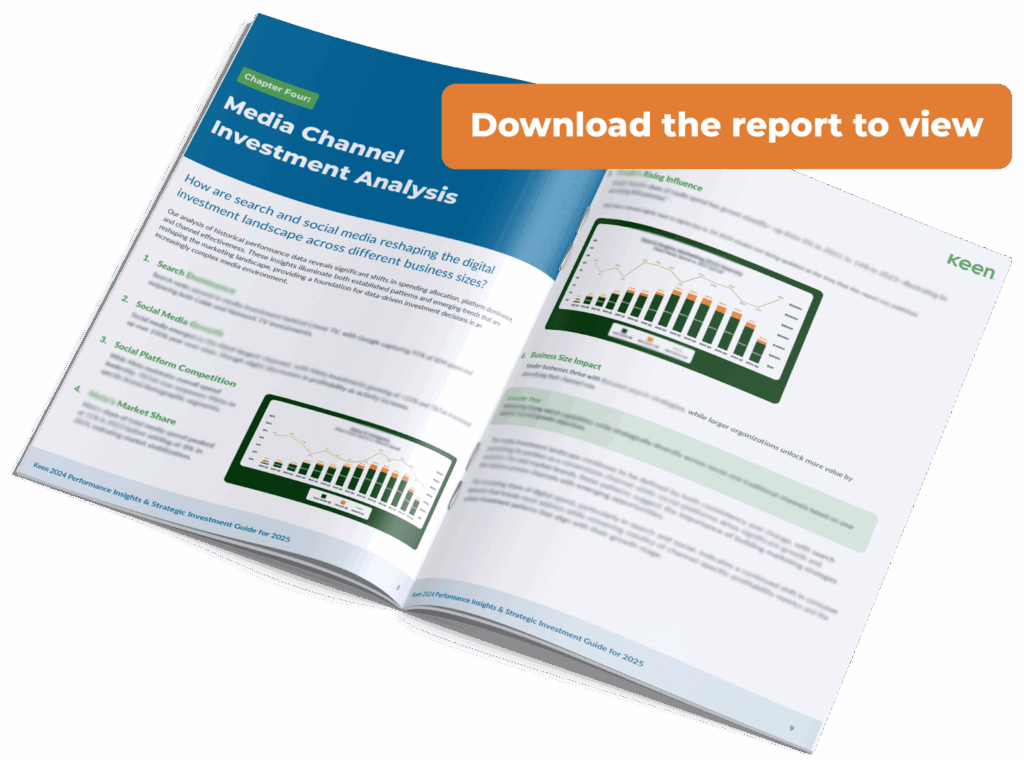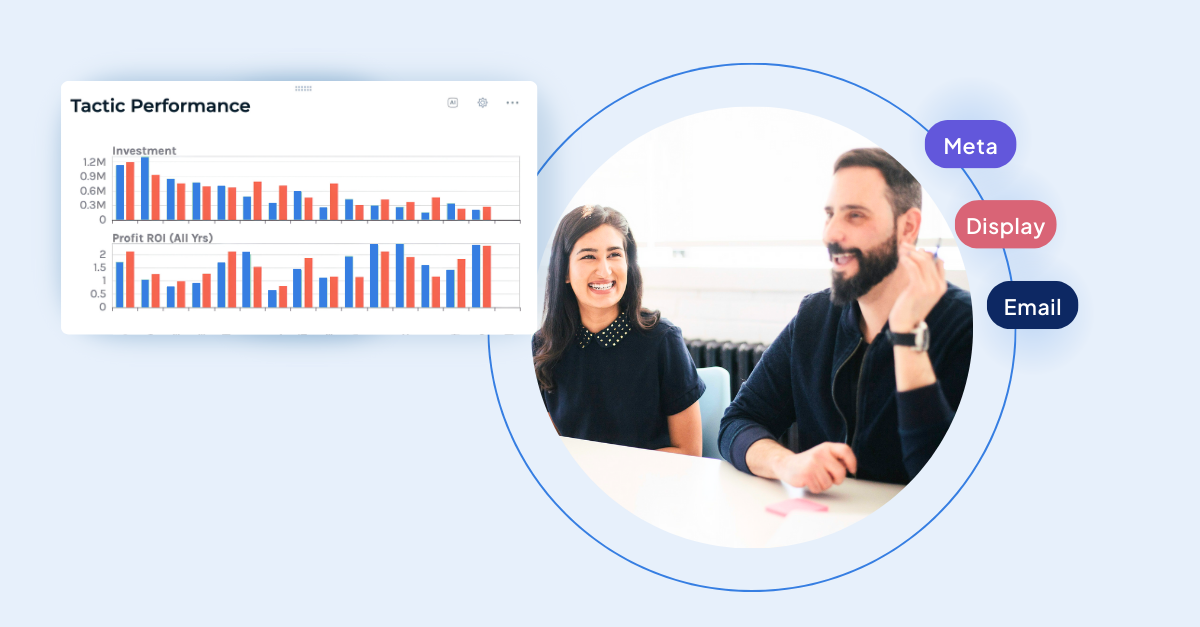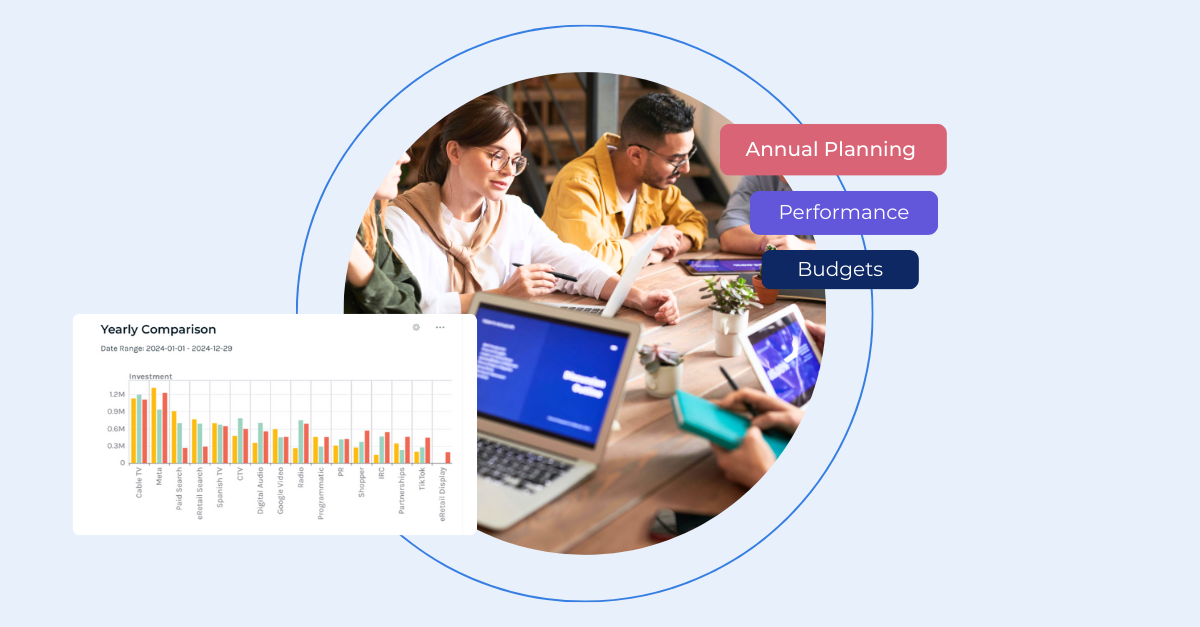Most marketing budgets leak dollars because spend is tied to impressions and guesswork, not actual business outcomes. Marketers face mounting pressure to prove every dollar delivers real results. Yet, without clear attribution or control, many fail to show measurable return on investment (ROI).
Performance marketing addresses this challenge by linking spend to tangible actions and making every campaign a testable, trackable investment.
Key highlights:
- Performance-based marketing is a measurable, outcomes-first model that links spend to actions and revenue, not impressions.
- While traditional marketing focuses on reach and awareness with no guaranteed outcome, performance marketing tools use precise pricing, transparent attribution, and agile optimization across channels—compounding ROI over time.
- Keen’s MMM platform provides the measurement, planning, and optimization tools you need to build a high-ROI performance marketing strategy.
What is performance marketing?
Performance marketing is a results-based, data-driven approach in which advertisers pay only when a defined action occurs—a click, lead, sale, or subscription. It ties spend to measurable outcomes, not exposure.
Most digital performance marketing campaigns run across paid search, social, native, and affiliate channels, with clear pricing models and real-time attribution to determine what delivers value. Traditional marketing buys impressions or reach upfront and hopes those exposures move the market. Performance-based marketing reverses that risk: payment occurs after you achieve results.
| Criteria | Traditional marketing | Performance marketing |
|---|---|---|
| Cost model | Upfront spend for reach or exposure (CPM/flat rate) | Pay for outcomes (CPL, CPS, CPC, CPA) |
| Metrics | Impressions, estimated reach, brand recall | Clicks, leads, conversions, sales, ROI |
| Budget flexibility | Less flexible, usually locked upfront | Adjustable at any time, based on performance |
| Optimization | Slow, less granular | Real-time, targeted, and data-rich |
Why brands are shifting toward performance marketing growth
A performance marketer can use live dashboards to reallocate spend mid-flight, pause underperforming creative, and scale winning campaigns—offering a level of control that brand-first, fixed media buys rarely match.
Your marketing becomes agile. Benefits include:
- Pay only for results: Avoid wasted spend on unproven impressions.
- Actionable, real-time data: See instantly what works and what does not.
- Flexibility and scalability: Shift budgets and strategies any time.
- Lower risk: Continuous optimization reduces wasted investment.
- Granular insights: Analyze performance by channel, campaign, or creative.
Advanced performance marketing tools like the Keen platform deliver even deeper measurement, gathering results across all channels for clear insights and better marketing outcomes.
How does performance marketing work?
Performance marketing works when every dollar invested is directly tied to measurable results—and when marketers have the visibility to optimize spend across channels in real time. Success depends on connecting fragmented data, understanding which investments truly drive growth, and continually reallocating budget to maximize return.
The best performance marketing platforms—like Keen—sit on top of your existing stack to unify data you already collect. With our Marketing Elasticity Engine (MEE), Keen forecasts the financial impact of every channel, campaign, and tactic—before you spend. This means you can plan with confidence, adjust investments proactively, and prove marketing’s contribution to the bottom line.
Instead of guessing, relying only on your marketing expertise, or looking backward, you get forward-looking clarity with Keen: where to invest next, how much to spend, and what results to expect. That’s how performance marketing works at its best—data-informed, outcome-driven, and fully optimized for growth.
Performance marketing steps
Here’s a breakdown of the steps you can follow as part of your performance marketing initiative:
- Set measurable goals: E.g., acquiring 5,000 app installs or reducing cost per acquisition by 20%.
- Choose the right channels and partners: Examples include Google Ads, Meta Ads, affiliate networks, or traditional media.
- Launch campaign with tracking: Use UTM parameters, tracking pixels, and APIs for real-time marketing measurement.
- Monitor performance continuously: Track KPIs such as ROAS, CPC, and conversion rate.
- Optimize campaigns using data: Refine targeting, creatives, and bids based on insights.
Which channels power digital performance marketing today?
When it comes to marketing spend, digital channels dominate—with seven out of 10 sectors dedicating more than 60% of their budget to online channels, according to a Gartner survey.
Examples of performance marketing channels include:
- Social media advertising: Platforms like Facebook, TikTok, and LinkedIn offer precise demographic and behavioral targeting. For example, Instagram Shopping Ads enable brands to drive conversions directly from product posts.
- Search engine marketing (SEM): Google Ads and Microsoft Ads deliver high-intent traffic. SEM is ideal for bottom-of-funnel performance goals such as lead generation or sales.
- Display and banner ads: Display networks serve visual ads across the web. Native display ads (like Taboola or Outbrain) often deliver better engagement due to their contextual placement.
- Affiliate and influencer marketing: Third-party publishers or influencers promote your product in exchange for a commission.
- Email and remarketing: Automated email workflows and remarketing ads re-engage users who haven’t converted, often reducing CPA.
- Content marketing: Blog posts, landing pages, and lead magnets are optimized for SEO and conversions. Content upgrades (e.g., downloadable guides) can boost conversion rates when paired with compelling CTAs. No wonder Google Search remained the highest-performing digital channel in 2024, according to Keen’s exclusive marketing insights report.

How to develop a performance marketing strategy: Key steps
Developing a high-impact performance marketing strategy requires more than running campaigns. We’ve put together these steps to create a results-driven approach:
- Define clear marketing objectives: Start by setting measurable goals, such as lead generation, conversions, or revenue growth. Knowing exactly what success looks like allows every marketing dollar to be tracked and optimized.
- Map the customer journey: Understand where your audience engages with your brand and which touchpoints influence decisions. This ensures your campaigns target the right people at the right moment.
- Choose the right marketing channel strategy: Evaluate digital performance marketing channels—paid search, paid social, programmatic, email, affiliate marketing, and retail media—and determine where your audience is most active.
- Collect and centralize data: Gather performance metrics across all channels to identify patterns and opportunities. Centralized data eliminates guesswork and provides a single source of truth for decision-making.
- Use AI-driven forecasting: Predictive analytics in marketing helps to determine the optimal budget allocation across channels. Keen’s Marketing Elasticity Engine goes beyond reporting, showing how each investment drives business outcomes before you spend.
- Once your campaigns are live, keep optimizing them: Performance marketing growth requires iteration. Run experiments, measure impact, and continuously refine campaigns to achieve a better ROI. Work with a marketing mix modeling provider like Keen for a holistic view across channels, so you can see what’s working, cut wasted spend, and forecast future outcomes.
Performance marketing example to inspire you
By using performance strategically, brands can drive significant growth. Case in point: a leading quick-service restaurant (QSR) chain achieved a 10% increase in revenue and a 21% improvement in profit ROI after building a marketing plan prioritizing return, not just spend.
The brand was struggling to understand the true impact of their media investments. After implementing Keen’s marketing optimization software, they gained visibility into the marginal ROI of each channel, which enabled them to make data-driven decisions and optimize their media mix.
Read the full marketing ROI optimization case study.
What are the common challenges in performance marketing optimization?
While performance marketing offers measurable results and data-driven insights, brands often face these key challenges:
- Data fragmentation: Marketing metrics are often spread across multiple platforms, making it hard to get a complete, unified view of performance.
- Budget allocation uncertainty: Deciding how much to invest in each channel without clear ROI visibility can lead to wasted spend.
- Marketing attribution complexity: Understanding which touchpoints drive conversions is often difficult, especially across multi-channel campaigns.
- Limited forecasting accuracy: Without predictive insights, performance marketers struggle to plan future campaigns effectively.
- Balancing brand and performance: Over-focusing on performance can hurt long-term brand equity. According to Nielsen Compass data, a brand loses 2% in future revenue for every quarter it doesn’t advertise — findings that underscore the importance of balancing immediate results with sustained brand presence.
- Scaling successful initiatives: Even high-performing performance marketing campaigns can underdeliver if insights aren’t actionable or if resource allocation isn’t optimized.
Bring performance to your marketing initiatives with Keen
Whether you’re running seasonal promotions, retail media, or annual demand planning, performance marketing optimization can give you a measurable, dynamic edge. Keen supports all these roles by modeling spend impact, enabling scenario planning, marketing measurement, and incremental revenue gains.
Our performance marketing solution ingests all your digital (and offline) channels to give a holistic view—not just digital performance in isolation.

Discover how to drive business growth with the best performance marketing solutions from Keen. Book a demo now.
Frequently asked questions
Performance marketing vs brand marketing: What’s the difference?
Both performance marketing and brand marketing play critical roles in a company’s growth, but the difference is that performance marketing emphasizes measurable, short-term actions (clicks, leads, or sales), while brand marketing centers around long-term outcomes such as awareness, trust, and loyalty that shape overall market perception.
Keep learning: Everything to know about performance vs brand marketing
What is performance marketing vs digital marketing?
The difference between performance marketing and digital marketing is that digital marketing covers all online strategies for awareness and engagement, while performance marketing focuses specifically on measurable, results-driven actions. Here’s a breakdown:
- Digital marketing may include activities that are harder to measure directly—such as brand storytelling, thought leadership content, or broad awareness campaigns.
- Performance marketing is tied to concrete metrics such as CPA, ROAS, or conversions.
This approach makes performance marketing strategies highly accountable and attractive for businesses that need to prove ROI quickly, whereas digital marketing provides a broader foundation for long-term brand visibility and customer relationships.
What is performance marketing vs. affiliate marketing?
Affiliate marketing is a specific performance channel—typically relying on partners or publishers who get paid only when they deliver results. Performance marketing is a broader, goal-oriented strategy that includes affiliate but also encompasses paid search, social, display, and any pay-for-results tactic.
Who uses performance marketing?
Performance marketing is used by:
- Brand marketers who need to justify spend with ROI and forecast outcomes.
- Marketing leaders managing full portfolios, aiming to optimize across brands.
- Agencies looking to go beyond media buying and offer strategic, outcome-driven planning to clients.
Is Keen a performance marketing platform?
Yes—Keen is more than a performance marketing platform. It’s a marketing mix modeling solution that connects marketing investment to business outcomes across both performance and brand channels.
With features in forecasting, media planning, demand planning, retail media optimization, and real-time ROI modeling, Keen bridges marketing and finance—so you can both measure and plan strategically. It’s built to deliver not just performance, but profitability and growth.





